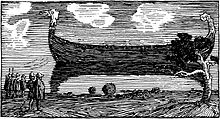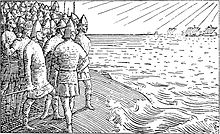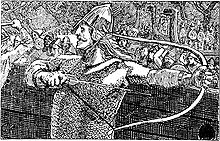Ormurin langi
Ormurin langi (literally: the long worm , actually the long snake , see Midgard snake ) was the name of the long ship of King Olav Tryggvason of Norway . It had 34 row benches and the kite head and tail at the end were gold plated. The long worm is estimated by extrapolating known ships to a length between 45 and 55 m. It was certainly no wider than 8 m. One assumes a sail area of 200 m². It was rowed by 68 men. With a double occupation, there were 136 rowers. Snorri also counts about 45 pure fighters.
The Faroese ballad of the same name by Jens Christian Djurhuus , which he wrote in Kollafjørður in the Faroe Islands around 1830 , is well known. It is one of the most popular folk tunes there to this day . The piece has 85 stanzas, with a refrain in between. In 1884 the text appeared for the first time in print in the newspaper Dimmalætting and in 1891 finally in VU Hammershaimbs Færøsk Anthologi . The refrain is as follows:
- Glymur dansur í høll,
- dans sláið í ring!
- Glaðir ríða Noregsmenn
- til Hildar ting.
Pronunciation in IPA phonetic transcription:
Translation:
- Noise rages in the hall,
- Dance with you in the ring!
- The Norwegians ride happily
- In the direction of war.
[Hilda as a symbolic figure of the Northern War; see (web) links]
The song is about that very King Olav Tryggvason and the naval battle of Svold . Olav had the ship built and it was to be Norway's largest ship. Shortly before the launch, an archer named Einar Tambarskjelve, who had extraordinary powers, contacted him. The Norwegians set sail in good spirits. But the news got around quickly, and so the Danish King Sven Gabelbart and the Swedish King Olof Skötkonung discussed how they could get rid of Olav. As the third conspirator they invited the Norwegian Jarl Erik Håkonsson , who was supposed to avenge the death of his father Håkon Jarl in this way . The three fleets positioned themselves in the Oresund and waited for the Ormurin . While the Norwegians managed to put the Danes and Swedes to flight, Erik had more success and was finally able to conquer the ship after the king's bow failed in Einar's hands and he could not incapacitate Erik. King Olav and his surviving men jumped overboard and committed suicide.
The text is based on Icelandic traditions .
The Faroese metal band Týr released a version of the ballad on their album How far to Asgaard .
Ormurin Langi in art
In the short story "Ormurin Langi" by Tjure Sigmarsson, a skald tells a less glamorous version of the legend of the golden ship.
Footnotes
- ↑ Heimskringla. The story of Olav Tryggvason. Chapter 88.
Web links
- Ormurin langi (original text in Faroese)




